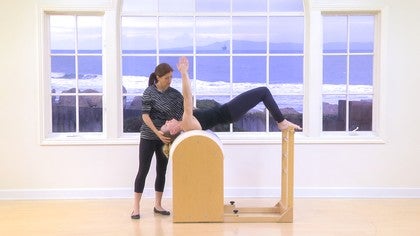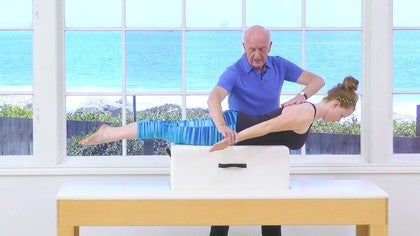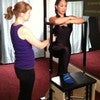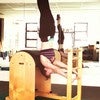Description
About This Video
Transcript
Read Full Transcript
Hi, there, my name is Juan. I'm here with Juliana. I've been asked to do a class focused on the mobility of the thoracic spine. We're going to use the trapeze table, or the Cadillac, especially the tower bar. We're going to try to get some sort of specific movement into the thoracic spine, and then we try to progress or to integrate that mobility that we achieve, that knowledge, that proprioception and understanding of thoracic spine into a more functional movement.
Okay? So I hope you like it. So, Juliana, we're gonna sit on the trapeze table. We're gonna do like horseback. One leg to every side.
I'm gonna use a blue spring. It can be even a red one, but I think a blue can be okay. And I'm gonna use it crossed because I'm very interested in work on this range with the assistance of the spring. Okay, so let's try to move forward just a tiny bit. Okay, do you have these reins?
Yeah, is that okay for you? Mm-hmm, it's fine. Okay. So first thing we're gonna check is that they can go overhead and that the range is not too much for them. So I think even for you, Juliana, we're gonna make it a little bit forward, so that's it.
Make it more interesting. All right, that's it. So, first thing we're gonna do is to work on the shoulder blades. All right? Okay.
So I want you to really elevate the shoulder blades. That's it, and I want you to go really forward. That's it, so that's the idea. Okay, so be careful that they don't release the bar, but what you can do is you can help them to extend and very gentle. It is not like a manipulation.
It's just some sort of information from the thoracic spine. You can create this little input in different parts of the thoracic spine. Are you feeling okay? Mm-hmm. It's too much? No, perfect.
Just a little bit of pulling. Can you feel that? Mm-hmm. And at the same time, we want to move the vertebra from posterior to anterior. Alright.
And this kind of gentle, bouncy feeling is gonna help you to create more motion into the thoracic spine. That's it. Cool, great. Okay, now we're gonna depress, and I want you to release. Okay, so let it go here.
So this is just to warm up. This is just to create some sort of information and * into the thoracic spine, so it's good for clients to start with. And then we're gonna try to move in a more active way, so I want you to go back here. That's it. We're gonna take this, and I want you to extend your hands.
Okay. Let's make it a little bit farther. Okay, alright. So that's it. That's what you want.
Maybe farther away. Okay. That's it, cool. So what I want is that you are with the arms parallel, but you really need to get, the bar is too heavy for you? No, it's fine. No? It's fine.
Okay. We're using the horseback position because in a way it locks the lumbar spine, so it creates hip flexion and hip abduction and some sort of connection with the legs, so it is great to reduce the movement into the thoracic spine. So from this position with proprioception, the information that the bar is providing us, we can move the thoracic spine in a very easy way. So, first thing I want you to do, I want you to keep this on the same place. I don't want you to move the tower bar, and I want you to take the thoracic spine forward.
Just forward, that's it. Okay, so the shoulder blades are going close together. Right? Mm-hmm. So the whole ribcage is going forward.
From there, you keep this, and I want you to go back. Okay? Back towards you? Yeah, so you flex the spine. In flexion In flexion.
Yeah, so the sternum is going back. Okay. That's it. Okay, I know, I know. That's it.
Okay? So I prefer not to talk to you so much. That's why I wait so you'll figure out. So with a little bit of touch, you go and create the motion. Alright?
So I want you to really go back, back, back, back, back, back, back and create a lot of movement here in the thoracic spine. Okay? So you are kind of pressing there. The head is looking over the bar. Great.
And you are creating all this flexion, and you probably will concentrate in different segments, right? So you can create information in all, in the whole spine. Okay, so now we keep this like a fixed point, and the whole ribcage and the sternum is going forward. Completely forward, forward, forward, and the shoulder blades naturally go into retraction. Great.
So you find and you try to look every vertebra going forward. Great, great. And now we go back, so the whole ribcage goes back. Okay? So the idea is that we are not going into flexion extension.
The flexion extension is created by this forward and backward movement. Alright? So try to make it a little bit behind. That's it. Breathe.
Let that breath in. Open, creating movement into the costotransverse joint, and then we go forward and completely forward. That's it, cool. Can you feel the thoracic spine? Oh, yeah.
How is it kind of active, extension there? Yeah. All right, so once we have that, we're going to the neutral position. What you feel is your neutral position, okay? The shoulder blades are a bit more separated you are in a lengthened position here's good, okay?
There's one part of the thoracic spine that we usually forget to work that is the junction between the thoracic spine and the cervical spine. I think it's crucial to work here and sometimes we don't have enough input and enough movement, so I want you to have a look and think about this part of the spine. With this very easy exercise to do. Now, we're going to keep the arms and the tower bar stable, still. We're going to take head forward, that's it.
And go on, go on, go on. I know this is like sacrilege, like this is a sin. But again every movement is good, there's no bad movement. You need to learn how to control it. Okay, so go forward, forward, forward, forward.
Keep going, you're not going to die. Okay, and from there you keep it and we go backwards. Okay. Okay, complete lean backwards. Try to understand what is happening with the rest of your body.
And I want you to go back, back, back. So your eyes keep the same line. So your nose and your chin. That's it, perfect. Keep the same line and this is where we're creating the movement, you feel that right?
Yeah, yeah. Really go back, back, that's it. Look at the muscles working. You're probably never been into this range, so this is the range we need to work. The ones that we don't control, that we don't reach ever.
And now, go forward, that's it. Keep going, touch the window with your nose. Really, it's very important. I don't know why, but it's very important for you. That's it, perfect.
And you feel some sort of movement there. And now we go back, keep the line of the eyes at the-- That's it perfect, beautiful. And keep lengthening and back, back, back, back. Great, great. And now let's go to neutral, okay?
So now we're going to do both exercise one after the other, okay? So we start the neck forward, that's it. If you need to help your client to get that sense and then we go backwards, great. And now we go backwards with the ribs, as before. That's it, keep it behind, behind you.
Feel the whole thoracic spine and now you go forward, that's it. Really let your spine to move forward. Don't be afraid of taking the sternum, there you go. And now you go forward with the head, backwards with the head. Backwards with the thoracic, there you go.
Really wanna go. You can even extend the legs, so you can really that's it. Look all this motion here that you can. Good, and then you go forward, that's it. You go head, head back, thoracic, extend, so you really going to the more difficult parts of the thoracic spine and go forward shoulder blades just react, right.
That's it and then you come to start with the neck that would be the sequence that you would be doing. You can do it more dynamically in a way, you can play with different combinations. But the idea is that you can try to reach the motion every vertebrae possible and try to get even more range that we are just do, okay. I'm just moving the thoracic forward and backwards with this position is going to drive a lot of movement into the thoracic spine, okay? Are you ready?
I'm ready. Let me take you there, I want you to feel, like that's it. You have some sort of support here. You okay? Lift the sternum back, up a little bit.
And I want you to just hold, holding with this hand Only this. Yeah, just that. We gonna play with the rotation but again is going to be very specific for the thoracic spine and we're going to adjust the shoulder blade to help and also the tower bar. I want you to reach the wall. And it's very important that this is not moving.
I know, it doesn't move. It doesn't move, you really go forward, forward, forward. Depending what you want to do with your head, if you don't want to create constant rotation here you can turn the head, but I think is even more interesting if we keep this-- Oh, I see. That's it, this side there, okay? You really, really go deep here.
You're closing the spine, can you feel that? You're kind retracting here and control the bar. You are driving all the rotation into the thoracic even though could be difficult to see, when you noticed and when you experience the exercise you'll see that there's a lot of motion here. Now we keep this as a fixed point, then we drive back. You have a retraction, you keep pushing with the right arm.
Keep it really, really, really behind you. You feel this retraction, you feel the extension, try to keep it really, really in position, all right? The neck up, remember as before we want to lengthen. That's it, can you feel this, the thoracic spine? Yeah.
We're going to do it again. You rotate from this, this stable point, this is the fixed point, that's it. That's it. You feel that if I do this little cue, you understand where the movement comes from, okay? Keep going, and if you can look at your fingertips there, that could be awesome.
Perfect, and now shoulder blade and the shoulder blade that is helping the spine and you keep this, okay. That's it, you keep it closed and you lengthen and you go up and if you combine with the exercise before and you take the vertebrae onto the sternum you'll feel even more extension and rotation there, okay. And then we come back, okay. Sometimes we do the exercise with this arm and that's very common but if you increase the range here it's very easy that you, should take the movement somewhere else. The idea is just to really keep it into the thoracic spine, so limits the movement with the arms and using the tower bar as a reference so you can really get the motion into the thoracic spine in the most stiff part that is usually between the shoulder blades, okay?
Let's do the other one, okay? First, we did protraction, you drive forward look at your fingertips. Hold this bar, okay? Just for safety and go up and then you want to closed this space, Can you feel that? It's pretty cool.
And I want you to feel some sort of retraction here. Lengthening, and you go really, really, really far with that, that's it. You feel that even shivering? Yeah. This is the new range.
This is the nervous system trying to be, to create that motion and because it's not fast enough, it's not efficient enough you see the discontinues signals of the nervous system. They're getting faster, but not now. You keep it and then shoulder blades. I really want you to start from the retraction that's pretty cool. The retraction is driving the rotation, that's it.
We come back. You keep this as a reference, this is the fix point. Cool. And there you go. And retraction, retraction, you don't even need to think into the rotation, is the retraction that is creating the... that's it.
And you it's very different one set to the other, right? It is, it is. Let's go, over there, okay? Let's do it again. I'm going to help you with this to create a stronger fixed point here.
Lengthen your spine, beautiful. That's the window, close this space here. Really going to protraction. Again is the arm that is creating this rotation. Awesome, beautiful.
And now we keep this stable and this retraction and try to keep this kind of lower, make it smaller than before all right? Because it's probably to difficult for you now. That's it, that's it. I want you to keep it there. Okay.
You create pressure there, cool. And now, the retraction, that's it. You don't need to see a lot of movement out but you feel a lot of movement in. Oh, yeah. That's it.
Let's do it again. You go forward, this point is fixed. That's it, you lengthen, you open, lower, beautiful. This shoulder blade, that's it, a little bit retracted. And you extend and then you come back.
Make it... that's it, make it lower, okay. That's the idea, that's the idea. You feel that right? Oh yeah. Awesome, okay.
Now, we're gonna hold it. You can let the bar go up, let it go. Oh, let it go. Okay, how are you? Good.
Feeling good? Oh, yeah. A little bit more information up right here. Okay, now you have more tools to work on. Now we can use this specific information more integrated exercise, okay?
You're going to move forward again as before. Okay. That would be nice. I want you to take your seat bones, your pelvis and put it behind. You feel that your weight is on your hips.
We're gonna take the bar again, all right? Now we're going to challenge the extension you just experienced with a hip flexion, all right? Okay. The idea is just create a hinge from the hips. Okay.
Imagine that you have dowel or we could even use a dowel to do the exercise but I want you to go forward with the pelvis over the hips, that's it. And then we come back, all right? Imagine that the sacrum is going up, the seat bones is going behind and out and then you roll your pelvis open your hips, that's it. When I see that the movement is flexing you we're going to just stop. For now.
So keep going. For now you can do that, okay? And now up again. That's it, again think in your pelvis, rolling over a few more hits, good. That's it, that's what I want you to feel, okay?
This very nice organization which here some sort of retraction, stability in the ribs and movement in the hips, great. And now we hinge back up to the vertical position, beautiful. When we are sure that they can control this range when they don't go into flexing very easily, we can challenge the movement. The beginning now is the same, I want you to lengthen, I want you to rotate the pelvis over the hips, a few more hits and now, you can let your spine to move forward and to bend, but the movement is always forward, that's it. I don't want to see that the movement is coming to us.
The movement is really, really, really long in front of us. From there I just want you to move this armpit down a little bit so the other one is going up. Can you feel that, right? Just a tiny bit. Let's do the opposite.
Great. Again, is the shoulder blades that is creating the rotation in the thoracic spine. Stick the neck long, beautiful. Let's do it one more time. One of the armpits is going down and the other one is going up.
And now, we do the opposite. Are you okay? Oh, yeah. Now we go to the neutral position and as long as you are from the hips come back. That's it.
Great, so you take the ribs, and the rest of the body with you. We're gonna do it a couple more times but for the purpose of the class, that's enough. Now we are going to flex the elbows carefully. And we're going to do kind of the same in the higher position. I want you to hold the bar, so you don't lose it.
And first thing I want you to do is to take the sternum out and forward, okay? As we did at the beginning of the class but now you're going to do it more active way. Can you feel that? Yeah. Okay, the position of the pelvis, the hip flexion is creating more stiffness here so it's very likely that they go a lot of lumbar lordosis, that's why is a very nice position to work the thoracic extension.
And also the hands, the arms position is creating a lot of liver in order to feed the extension, okay? From there we're coming back, all right. So now, the idea is like the lower ribs are up and separated from the sacrum and with all the distance you go forward. That's it, beautiful. This is what you really want to move up and forward.
That's the motion that I want you to get. Can you feel that? Beautiful. And then we go up again. Every time you go to the neutral position, you probably feel that this space is longer, and longer and longer.
Okay, one more time. We go up, that's it. Great. And now from here if you like, we can create again this tiny bit of rotation. I would recommend to keep the head forward, so you create the counter movement in the cervical thoracic junction.
Sorry, it's a difficult word. Rotation, that's it. Beautiful. And you feel in a very specific way of the spine, part of the spine this motion. We come back up and then you release the shoulders.
And then you can let the bar too go down. Okay, how does it feel? Good, really good. You can really notice it, probably in the screen you can notice too a more lengthened position, easiness into the spine and very nice curve in your spine. I think it's kind of working, at least a little bit.
Let's play with this now, facing this side. Both legs are going to the side. And we are going to work again in the rotation using the tower bar, but now in this position, okay. I want you to please take, you can come closer if you like not that much. I want you to rotate your torso to the bar, that's it.
And this hand it's in front of this shoulder but you can hold it, and this one again. Okay, this is forcing you to create the same as before some sort of protraction here and some sort of retraction here, okay. Again, the position of the legs is creating some sort of stiffness. And this is going to challenge the rotation. I can use my leg as point of support for you and what I want you to do is really go forward and then you extend, okay.
Let the neck just continue the movement, all right. And I want you to move the shoulder blades there, I want you to elevation and breathe. You probably get movement to place it's not very usual to take it and there I want you to do retraction and extension to come back. you are not coming into extension, all right. The chest stays forward and up.
And keep going, keep going, keep going. Are you okay? Yeah. Are you breathing? Yes.
Okay, and let's do it again. We're going to combine the movement forward with the elevation, all right? Now the idea that you are doing the second time is like you try to take the ribs of the left side behind you that's it. And the ribs on the right side in front of you, okay? The rotation that you want to create could be too much, I hope this is okay with you.
And then we come back in extension. Retraction, depression of the shoulder blades sternum is going forward and up. And there you go, okay. And let's do it one more time. You really go into your hips, you go forward.
Let the neck lengthen, beautiful, that's it. And again, this right ribs are going forward and the left ones are behind, great. And now we start from the shoulder blades, the sternum is going up, forward. And then creating some sort of fulcrum point so you can create the movement here, all right? You probably feel that I'm helping you here not to compensate with the hips and really drive the movement into the spine.
Great, let's bend your elbows. Perfect. And leave it there. We're gonna do the other side, we can see from the back. Okay, take the pelvis back, that's it.
Feel that you are supported in front of your seat bones, kind of, that's a stable position there. We are going to create a rotation to the right in this case. Your hand is in front of this shoulder and this is happen the same. You're going to a little more upright posture. I will help you creating some sort of fixed point here.
And then we just let go forward, just let the movement to happen. Okay, all right. Just breathe, let the gravity help you with the movement. You're just lengthen the neck. The first time I'm not gonna make a lot of emphasis on anything in just to explore the movement.
To se what happens with your movement. And then when you come back you do a little bit of retraction, depression and the sternum is going forward and up. Good. That's it, should probably feeling this recruiting here. Okay, let's do it again.
You go forward, and now I want you to focus on the elevation of the shoulder blades. You really move the bar, you want to move the bar as far as you can. And I want you to kind of lengthen this side, and I'm going to help you to create some rotation here. Just a tiny bit, you want to feel, you want to push the t-shirt here. There you go, perfect.
And head is just looking down, okay? And the we come back, shoulder blades down, back. that's it and this is where I need you to take the movement your body, your system trying to go to place where is more used to move, but now we tried to try the movement to the places that are a bit more stiff, okay? It's a bit unfair but it works better. Okay, use the shoulder blades to drive the movement.
Try to lengthen here. You can also work on closing this side if you like. Can you feel that? Yes. This is going to help you to bring more opening here.
And then try to find this rotation, so beautiful. Breathe a couple of times. Let the head go forward. That's perfect. No worries if the shoulder goes to the ears that's completely normal, that's completely okay.
Now we do the retraction, depression, extension of the thoracic spine having some movement here. That's it. And you go up, awesome. And then I want you to bend the elbows and if you like in this side, you haven't done on the other one going to extension here. Okay, so the idea is the movement is not going there, the movement is going that way.
And the right side of your ribs is going behind and left side of the ribs is going forward to the head is between the arms and the shoulder blades are helping you to create more rotation, okay? You can leave the bar over there, it's not going to move. That's it. How does it feel? Good, really good.
Good, now we stop playing with the tower bar for a tiny bit. We're going to use the yellow spring to keep moving the thoracic spine in a less supportive way. We're probably going to come back to the tower bar soon. We're going to do the kneeling cat exercise on the Cadillac. That's it, we're going to be kneeling.
I'm going to take this out of place here. Okay, there you go. All right. The distance of your arm, that's it. The springs are kind of vertical, maybe a little bit towards you, okay.
I want you to curl your toes down. Make a wider, yeah step with the knees because now we're going to rely and to use the hips to create some sort of support. Before we were using just the seating position and horse back to create stability. And now we're gonna go into more hip flexor but it's a more active way, all right. I think we need to go backwards a little bit.
All right. Awesome. So now what we do is to hinge the hips back, as far as you go forward, backwards, sorry. And the seat bones are going towards the wall. You are lengthening and extending the arms forward, okay?
You should feel a little bit of support but not too much. Enough, lets say enough. I want you to try to find some sort of lordosis even though is not going to be huge, but it's the sense of going really, really deep into your hips, all right? From here we're going to recover the exercise we did before. I want you to do elevation and depression.
And when you do depression, I want you to feel a little bit of lifting into the sternum, just a tiny bit. It's difficult to see it but you definitely will feel it, right? Oh, yeah. And now I want you to go into elevation again, okay? Try to lengthen the neck and I really want to move the shoulder blades up, if you can touch your ears, perfect.
Really, perfect. I want you to explore all this range, and now you go back. The idea when you do the retraction and the depression is that the vertebrae, the spine process are moving towards the sternum. Beautiful, that's great. And this is creating a lot of stability here.
And now you go up, great. And down to the pelvis. And imagine the spinal process moving from posterior to interior into the sternum. Are you okay here? Yeah.
Okay, from here we're going to come back and this time we're going to do it in neutral position. You have retracted the shoulder blades and I want you to extend here. But just try to keep it neutral. Okay. _ Okay, you go up, that's it.
And the pelvis is going forward again. Okay, so the time you come by with the spine the pelvis is moving forward. This is kind of the movement, that we're going to like the beginning, alright. But reverse. Okay.
Let's do it again. Let me just tiny bit, really low into the pelvis. Really deep into the groin. This is where the movement starts. Beautiful, awesome.
And you don't go down, go-- Go out. That's it. Go out, okay. Sometimes what I do to give a little way of feedback here, put the head like, that's it. I have your arm with my elbow and my wrist and my hand, sorry.
And I have your head here, and from here, that's it, you do the elevation and you can create this little bit of feedback perception here. And then we go down, that's it. Let the spine process to go forward. Beautiful, great. And then you hinge back, shoulders... that's it.
Good. Now you understand much better that the shoulder blades are helping you to create that kind of stiffness there. And you go into the hips to do the extension. All right. One more time and we're going to do something different.
Hinge back, really low into the groin. Cool. Okay, you're going to keep it there now. I want you to focus on lengthen the fingertips, but at the same time you lengthen the seat bones back. You are not moving but inside you are feeling this actual elongation feeling.
From here as we did before, let's take the armpits of the left up and the other one down. Good. And now, we do the other side. This scapula is going into retraction as this other one is going into protraction. Are you okay?
Yeah. Let's do another one. And I'm going to give you some feedback for the neck. Rotate, that's it. Good.
And now the other one. In the ideal world you can move the shoulder blades but you don't move this too much. That's it. And the head is looking to the same spot now is the thoracis, right? Yeah.
Now you can't escape. That's it. It's a very specific, and it's very nice information to use than to move the thoracic spine, beautiful. And now at this time we are going to move back inflection. I want you to take the seat bones together a tiny bit.
That's it. The sacrum is going down and you're going to open the hips again as before but now let your spine to flex so the movement is going down towards the back. That's it, beautiful. Once you get the ribs on place, you extend it. Wow, great.
You take the pelvis a bit forward, that's it. Keep it there. Now we're going to do the exercises with this position. We're going to play with the flexion. And then we go into the extension, all right?
Let the head, let the nose drop a little bit, then the chin, and so the whole neck is going into flexion and I'm very interested in the vertebrae that moves the ranges that is difficult to get. Now we are trying to get this motion into the thoracic spine. I want you to press a little with the arms like, that's it. Okay. The protraction again is creating the flexion but you really need to reach.
If you don't reach your spine doesn't know that you want to flex it. That's it. Now, at this point, keep it there. Really hold here. This is what is preventing you to fall and when you feel that you can't go any further is where you go again deep into the hip groin.
So you are going into flexion. Okay. That's it. So the spine is lengthening I need a little more lordosis. That's it.
Beautiful. Gonna help you with some support here. Okay. The seat bones are going behind. That's it.
And the ribs are separating from the pelvis. This is the part of your spine that you really need to or want to length. Again, so you extend, extend, extend. With all this lengthening you are starting to take the seat bones together, the sacrum is following towards the knees. So you open the hips, beautiful.
The ribs are going behind. Make it slower, okay. Now that I have this position I want you to stack the rest of the spine, good. Take the pelvis a little bit forward, jut a tiny bit. That's it.
That is the idea, okay? We create some sort of awareness the more upright neutral position that we can get with you at this time, okay? Let the springs go down. And we're going to move to the next exercise, okay. Now Juliana, everybody, we're going to play with the tower bar.
All this motion, this segmental motion that you've learned into rotation, into flexion into extension we gonna apply into a more functional position where you have your feet on the ground. And we're gonna play with your body weight to use that extension and that movement into parts that we need for our daily life. We're going to come back to the tower bar at this point. Again, now the bar it's out of the trapeze and we're gonna cross the spring again. You can use a stronger spring, like a red one or you can even use two of them.
Depending the assistance that the person needs, all right? This is what we are going to do. The first exercise is the dead lift exercise. Is basically hinge from your hips, all right. And from there we are going to build the squat.
The squat is going to be over head. When you go into deep squat with your arms over head. You really have to have your thoracic extension ready. If it's not ready, it's impossible to do it. The good thing is that the tower bar provides a lot of proper section and help, it's gonna be very, very easy.
Very good to do. The idea is that you have success doing this, all right? First, we are going to bend the elbows just to prepare the exercise. We're gonna be far, forward. I can come on the other side.
A little bit forward. Can you step forward a little bit, that's it. Let's separate your feet kind of the distance of the trapeze. Okay. It's quite big.
It's quite wide, all right. Now hold it. That's it. Now you're in a neutral position, your elbows are extended you're gonna use them as another bar, so you're not going to create any movement there. Basically all the movement is going to be on the hips first and then on the thoracic spine.
The first thing is that you are going to hinge the hips back and that is creating this motion, okay? It's not that you're pushing the bar is that your hips are going backwards and the whole physics of your body is going to move the bar forward, okay? Now we're going to reach two possibilities. First, that you feel kind of stretching or you are falling, that could be the second. And the third is that we can see some sort of flexion into the spine.
That would be the limit. Keep it there, now. Because now I see, that's it. You're loosing some of the balance. Let's extend the hips and take the movement back in a perfect hinge, perfect.
Again, we're going to hinge back here. So we keep the lordosis, I really want to move away from my fingers, that's it. When you feel some sort of too much tension there or that you're loosing balance or that you are going into flexion, we are going to stop it, okay? This motion, you got it, it's good, good range. We can play with this, all right.
The next thing we're going to do is to bend the knees. Okay, when you bend the knees you keep going deep into, okay but not that low. Oh, okay. The idea is that the hips are going back, a little bit down, but you go down because the knees are bend, okay. And the idea is that you keep pressing forward, that's it.
The more behind, the more extension you need here. Can you feel that? Yes. Okay, keep breathing please. Stop it there, lengthen the neck.
You don't really need that far, that's okay. From here, I want you to feel some sort of retraction and you're gonna extend the hips and come back as one piece. No movement in the spine now. It's all from the hips, all right? Let's do it again.
So you hinge back, this movement is creating that motion, now you bend your knees, you keep going deep, you really bend your knees to go further and then you keep pressing so you can use the movement of the bar to create more extension into the thoracis spine, all right? And now, retraction and up. And forward with the hips. Okay, good. This is a nice exercise to keep working on the thoracic spine, thoracic extension.
And now we are progressing into the squat position, all right? But first the dead lift, all right? We gonna do the same again, here from the hips you go back. When you need to feel you are out of your range you flex your knees, you keep pressing, and you don't really want to go so down, you want to keep it higher. That's it.
That's it. Now from there, I want you to keep pushing but now it's time to let the pelvis go down. You are going to sit into the squat position. Now, good, keep pressing, I help you. That's it.
Keep pressing. Now your hips are in flexion, your lumbars are in flection the arms to be up, need to hold full range of extension into the shoulder, so this is, even though is in flexion, you probably feeling some sort of extension, okay. From there what we are doing is bending the elbows and let the bar go up. And now you are in a beautiful deep squat position. I'm helping you here.
Let the knees go a bit wider and breathe, okay. And now to come back I can help you. You want you to feel that it's the sternum that's going up and forward, as we did before, that's it. Beautiful. You almost...you don't need any help.
This is a way of building the deep squat with arms over head that requires a lot of extension but you are creating the pattern in a very organic way, so your system understands how to deal with it, all right? We gonna do the whole process again. First, you take the bar down, just as preparation. Okay, cool. Every step is important so we are going to review like a check list so we don't forget.
First, is hinge back, that's it. Now you keep bending your knees, you keep moving forward so the seat bones, not that low, seat bones behind, arms forward, you create the extension, the neck is perfect. And now from there, you press, and you sit. Keep the knees aligned. I help you here.
Beautiful, you are going very, very deep into the hips. Now, depress your shoulder blades, bend the elbows a tiny bit, and then we go overhead. Great. Feel the feeling before, like retraction and depression. And the sternum is going up and forward and you go up, okay.
Once you have this, and you have it, you can go directly to the full squat, okay. Straight down from here? The idea now, the beginning of the exercise is the same we are going to hinge and hinging back is creating the squat is a matter of physics. This is the only thing that we keep, so we hinge back and we keep the arms forward, up, sorry. And you, there you go.
That's it. You have the support of the spring and the bar to do it. And from there, that's it, go up and forward. Okay. All right.
If I wanted to work in a more specific way, I could create some more information here. So let's do it again, hinge back. Now I'm providing a little bit more input into extension. Can you feel that? I want you to do the movement from behind just do the movement really up and forward.
That's it. You feel that right? And do it again. Hinge back, there you go, look forward. Beautiful.
That's it. And then up and forward. That's it. Even though it doesn't look like thoracis extension you probably notice and you notice a lot at home that it works dramatically into the thoracis extension. It's a very nice way of working the thoracic mobility.
Do you like it? Cool. All right, we're going to keep playing on the trapeze. Now we're going to hand to help and facilitate the movement of the thoracic. Let's come back here.
And we, can we do it together. I want you to kneel in this position. Looking at this side? I will be here. It is very important when we are doing hanging hanging position, not to, I'm going to show you this way, not to take all this here and press it, because it's going to be very unconformable.
The thing is that you try to be very, very close to the bar. And with the fingers you hold it, this way this part is free and the skin is not pinching not creating anything bad for your hands. It's a nice way to consider and actually creates more strength into the hand. We're going to do that. Just slide your fingers hold it, basically with the fingers.
You can use the thumb to close it or if you don't want to close it really go together with the other one. So do this side. This is the strongest grip but if you don't like it you can use this. Okay. If you do it that way is going to be very weak.
The next thing will be the same, what you're doing trying to align wrist with the hand, okay. From there, can you come closer, yeah, you curl your toes down and I want you to seat, okay. Now let the foot go down because you're tall. That's it. And I want you to hang, you feel like you're completely hanging?
If you're very tall and you don't feel like you're hanging here, you can go and you can sit and you could hang here. But I think for you it's going to be enough from here, okay? Remember before I told you, I want the shoulders to touch the ears. Let's try the same idea, so you really, really, really hang from the most hanging position you already feel some sort of movement into the thoracic. From here the same as the whole class, you do repression and detraction.
And imagine that you want to take your body horizontal you want to do, that's the idea, okay. You're using all the information we learned from the class to do the depression, retraction and then you go really like horizontal, okay. You feel that? It feels a lot because it's very active, okay. You can keep it for a while and then from there you hang again.
If you like you can do flexions before just to release. If you feel the grip is getting tired, you release, you can shake it because sometimes is too much and this muscles are not very ready so from time to time it's good to release them. Let's do it again. Let's try to make a nice grip, then we hold. If you wanted, you can keep it that way, you can hold completely and now you depress, you retract and now you really want to go the more horizontal as you can.
Keep breathing, Juliana. Take the sternum, there you go, up, up, up. Breathe, breathe, breathe. That's it. And then, you rest.
It's a bit more challenging if you can do it completely hanging or you can use it on a bar, it's probably the best way when you have this level to keep working on the thoracic extension and to use all the power of the latissimus dorsi and the movement of the scapula to create more extension. You keep continuously creating more goals and challenging your system, and you know to be efficient and be able to do all the movement that you want to do . That was the mobility for the thoracic spine class. I hope you like it. See you next time.
Back Care: Thoracic Spine Mobility
Comments
You need to be a subscriber to post a comment.
Please Log In or Create an Account to start your free trial.
































